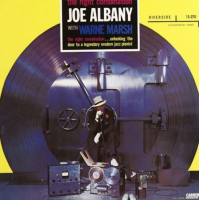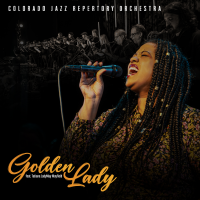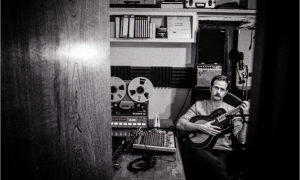
Joe Albany is a jazz footnote today. The late pianist, who began his career in 1943 and first recorded in 1945 with the Georgie Auld Orchestra, made remarkably few albums. Albany, who was deeply influenced by Bud Powell's attack and had smatterings of Thelonious Monk's and Lennie Tristano's abstraction, had terrible substance abuse problems throughout his life. The problems started soon after he began recording, and his drug addiction and range of accompanying legal issues that followed prevented him from recording between 1947 and 1956.
His first leadership recording appeared in 1957 and was likely a rehearsal. The album, The Right Combination, was recorded in the Long Beach, Calif., living room of drummer Ralph Garretson in September of that year. It's hard to conceive of a better album title, since this is a powerful work for exactly that reason. Producer Orrin Keepnews had a knack for titles that cut to the chase, and this one is no exception. On this album, Albany is featured with the splendidly dry tenor saxophonist Warne Marsh, bassist Bob Whitlock (who lived nearby) and Garretson, who plays on only a few of the tracks.
What makes the combination special is that all four musicians are emotionally tender, each struggling in real life but completely at ease while playing. For many jazz musicians with issues, playing was shelter from the pressures of everyday life that they found hard to deal with. For many of us, there is a market for what we do, fortunately, and we're able to chart a life course. Jazz musicians of this era had to be highly sensitive and vulnerable to perform the way they did while at the same time struggled to remain married, support a family and live a quality life. Many jazz artists found many of the things that come normal to us today way too difficult. Not only was the pay and demand for their services constantly in decline but also the only ones who seemed to understand them and the life they loved and lived were other musicians..
Joe Albany's life and addictions aren't to be pitied or analyzed. If his piano on this album speaks to you the way it speaks to me, then he has left behind an extraordinary gift that defies “why." The funny thing about most of these jazz greats is they just wanted to be left alone so they could share their hearts with fellow musicians and create a body of work that someday might touch a kindred soul. Nothing else mattered, not even the things that most of the rest of us hold dear. That's an enormous sacrifice for art, culture and the enrichment of other people's lives. So rather than try to make sense of the way artists like Albany lived, I urge you to listen instead to this album and just enjoy what Albany gave up to make it all possible.
JazzWax tracks: The Right Combination (Riverside) can be found under a different title here. For some reason, the only track missing is Daahoud (see below). It's also available to hear for free at Spotify.
For more Joe Albany and Warne Marsh in 1957, dig Live at Dana Point (VSOP) here. They were backed by Bob Whitlock (b) and Red Martinson (d). My guess is the Riverside album was likely a rehearsal for this gig (in October 1957) and other local appearances by Marsh, Albany and Whitlock. Dana Point, Calif., is about 50 miles south of Long Beach.
JazzWax notes: It's unclear whether Riverside's Orrin Keepnews produced this session or came into the tape. The latter is more likely. What's also puzzling is why Ralph Garretson is not credited on the back of the Riverside album jacket when he's clearly playing on several tracks. Be sure to dig Albany's solos on Angel Eyes and I Love You.
If you love this album, you may want to track down the CD version, which seems to be fairly expensive at this point. The sound is much better than the digital samples online.
JazzWax clips: Here's “Daahoud“ from the CD.
Producer Tommy LiPuma sent along a link to A Jazz Life (1980), a harrowing documentary on Joe Albany's life directed by Carole Langer. Remember, don't judge. Just absorb the creative struggle, the artist's honesty and transparency, and the art that was produced...
His first leadership recording appeared in 1957 and was likely a rehearsal. The album, The Right Combination, was recorded in the Long Beach, Calif., living room of drummer Ralph Garretson in September of that year. It's hard to conceive of a better album title, since this is a powerful work for exactly that reason. Producer Orrin Keepnews had a knack for titles that cut to the chase, and this one is no exception. On this album, Albany is featured with the splendidly dry tenor saxophonist Warne Marsh, bassist Bob Whitlock (who lived nearby) and Garretson, who plays on only a few of the tracks.
What makes the combination special is that all four musicians are emotionally tender, each struggling in real life but completely at ease while playing. For many jazz musicians with issues, playing was shelter from the pressures of everyday life that they found hard to deal with. For many of us, there is a market for what we do, fortunately, and we're able to chart a life course. Jazz musicians of this era had to be highly sensitive and vulnerable to perform the way they did while at the same time struggled to remain married, support a family and live a quality life. Many jazz artists found many of the things that come normal to us today way too difficult. Not only was the pay and demand for their services constantly in decline but also the only ones who seemed to understand them and the life they loved and lived were other musicians..
Joe Albany's life and addictions aren't to be pitied or analyzed. If his piano on this album speaks to you the way it speaks to me, then he has left behind an extraordinary gift that defies “why." The funny thing about most of these jazz greats is they just wanted to be left alone so they could share their hearts with fellow musicians and create a body of work that someday might touch a kindred soul. Nothing else mattered, not even the things that most of the rest of us hold dear. That's an enormous sacrifice for art, culture and the enrichment of other people's lives. So rather than try to make sense of the way artists like Albany lived, I urge you to listen instead to this album and just enjoy what Albany gave up to make it all possible.
JazzWax tracks: The Right Combination (Riverside) can be found under a different title here. For some reason, the only track missing is Daahoud (see below). It's also available to hear for free at Spotify.
For more Joe Albany and Warne Marsh in 1957, dig Live at Dana Point (VSOP) here. They were backed by Bob Whitlock (b) and Red Martinson (d). My guess is the Riverside album was likely a rehearsal for this gig (in October 1957) and other local appearances by Marsh, Albany and Whitlock. Dana Point, Calif., is about 50 miles south of Long Beach.
JazzWax notes: It's unclear whether Riverside's Orrin Keepnews produced this session or came into the tape. The latter is more likely. What's also puzzling is why Ralph Garretson is not credited on the back of the Riverside album jacket when he's clearly playing on several tracks. Be sure to dig Albany's solos on Angel Eyes and I Love You.
If you love this album, you may want to track down the CD version, which seems to be fairly expensive at this point. The sound is much better than the digital samples online.
JazzWax clips: Here's “Daahoud“ from the CD.
Producer Tommy LiPuma sent along a link to A Jazz Life (1980), a harrowing documentary on Joe Albany's life directed by Carole Langer. Remember, don't judge. Just absorb the creative struggle, the artist's honesty and transparency, and the art that was produced...
This story appears courtesy of JazzWax by Marc Myers.
Copyright © 2026. All rights reserved.




























